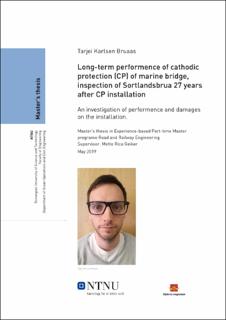| dc.contributor.advisor | Geiker, Mette Rica | |
| dc.contributor.author | Bruaas, Tarjei Karlsen | |
| dc.coverage.spatial | Norge | en_US |
| dc.date.accessioned | 2023-11-20T12:30:43Z | |
| dc.date.available | 2023-11-20T12:30:43Z | |
| dc.date.issued | 2019-05 | |
| dc.identifier.uri | https://hdl.handle.net/11250/3103580 | |
| dc.description | Long-term performence of cathodic protection (CP) of marine bridge, inspection of Sortlandsbrua 27 years after CP installation | en_US |
| dc.description.abstract | Concrete structures placed in or next to the sea are constantly bombarded with chlorides,
either directly from the seawater or by airborne chlorides. This can cause ingression of
chlorides on to the surface of the reinforcement of the concrete which then may start to
corrode. There are more than 7000 concrete bridges in Norway located close to the sea.
This thesis focuses on the long-term effects and how to ensure good quality with cathodic
protection (CP), which is a repair method that prevents further corrosion of the
reinforcement and can therefore increase the service life of a structure with several
decades. The work in this thesis has been performed using literature studies, field
investigations and laboratory analyses.
Sortlandsbrua is a cantilever concrete bridge which was built in 1975 and showed signs
of corrosion damage early in the 1980s. In 1990-1991 cathodic protection was installed
on the pillars to prevent further corrosion damage. The CP was installed using 3 different
methods, in combination with the long lifetime of the installation this makes it ideal to
investigate the bridge to study long-term effect of CP. The bridge was investigated during
the summer of 2018, 21 concrete cores were sampled from 4 different pillars to create
chloride profiles, μ-XRF scans and thin section samples. All the areas with CP was also
investigated for delamination of CP-mortar.
During the investigations there have been discovered protective and destructive
consequences of the CP over 27 years on Sortlandsbrua. Chlorides have been extracted
from the bridge concrete and ASR have been discovered at the reinforcement. Small
areas of delamination of CP-mortar were also discovered. There seem to have been
development of microcracks in the CP-mortar due to the impressed current from the CP.
Carbonated concrete seems to have affected the transportation of chlorides. The effect of
carbonated concrete on the chloride movement and different transport mechanism has
been discussed along with the consequences of the observed changes and damages.
There are suggested further investigations to supplement the findings here and give
better understanding of the findings in this thesis. | en_US |
| dc.language.iso | eng | en_US |
| dc.rights | Attribution-NonCommercial-NoDerivatives 4.0 Internasjonal | * |
| dc.rights.uri | http://creativecommons.org/licenses/by-nc-nd/4.0/deed.no | * |
| dc.title | Long-term performence of cathodic protection (CP) of marine bridge, inspection of Sortlandsbrua 27 years after CP installation. | en_US |
| dc.type | Master thesis | en_US |
| dc.source.pagenumber | 331 | en_US |

